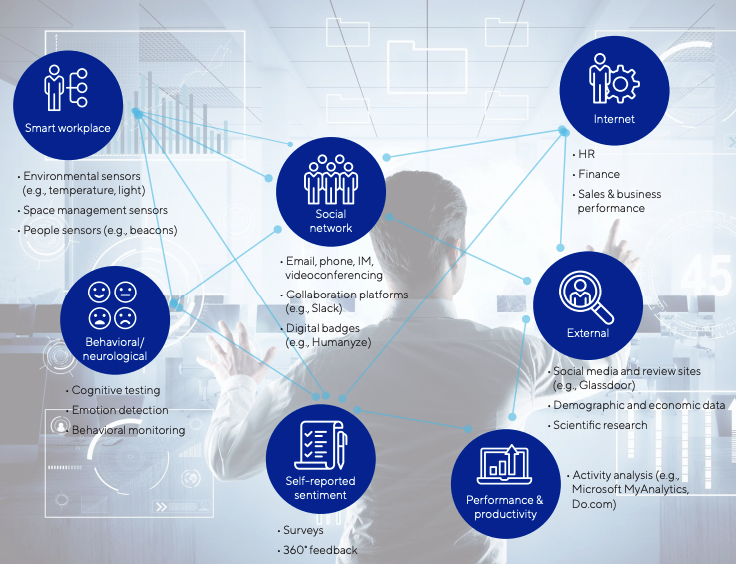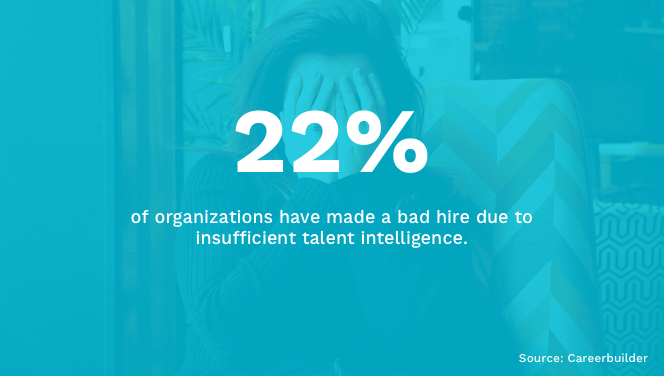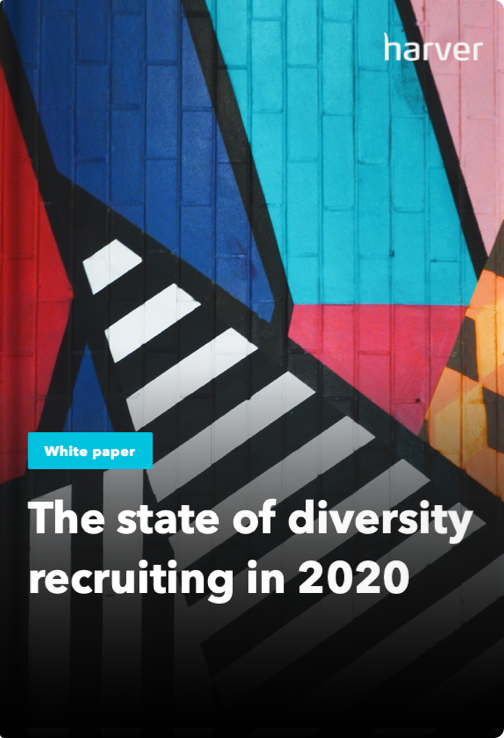The market is an increasingly competitive, ever-changing place – which only means one thing.
There’s more pressure than ever for organizations to operate at a faster pace.
Consequently, recruiters are always adjusting their strategies to stay ahead of the curve and respond to the fluctuating hiring needs. And one such innovation more and more HR & talent acquisition teams rely on is data-driven insights.
We believe talent intelligence holds the key to making better hiring decisions, both now and in the future.
But what exactly is talent intelligence, and why should you bother utilizing it?
Continue reading to find out!
What’s in?
- What’s talent intelligence?
- How to implement talent intelligence
- Why businesses should use talent intelligence
Like what you see?
Don’t miss out. Subscribe to our quarterly digest to get the latest TA and TM resources delivered right to your inbox.
What’s talent intelligence?
In short, modern talent intelligence provides talent professionals with a wealth of data to make better-informed recruitment and HR decisions.
How?
By collecting data on:
- Existing candidate pools
- Internal and former employees
- Passive candidates
- Your competitors
This information is then analyzed and formulated into comprehensive reports to highlight:
- Who wants to work for your company
- Who’s passionate about your industry
- Who’s a good fit for your team
Rather than focusing on just surface-level data, talent intelligence centers on the micro-level, exploring info like:
- Employment history
- Skills
- Salary
- Education
- Work performance and performance reviews
- Benefits
- Conversation history
- Social media history
Of course, you can also use talent intelligence to explore macro-level data like info about company culture, employment rates, open job requisitions, etc.

Your talent intelligence can contain data from a multitude of sources. It is up to you to find out which provide you with the most useful insights.
What else does talent intelligence do?
As we’ve just touched on, you can utilize talent intelligence to gather data to analyze what makes your workers happy (or what doesn’t). This is achieved by digging deep into the experience, skills, and education your workforce has.
You can also collect data on who your competitors have on board in what roles, what positions they’re hiring for, and what benefits they offer.
This enables recruiters a better feel for what works and puts them in a more favorable position to enhance their own recruitment strategies.
The same goes for analyzing talent within their own workforce. This gives businesses a better understanding of their own teams. You can use talent intelligence to identify your highest and lowest-performing employees and get to the root of any gaps in productivity.
In terms of reports, these are kinds of insights talent intelligence software can generate for you:
- Migration reports: These reports show where (senior) employees move onto after leaving your company, which helps to identify how and why competitors attract your talent.
- Source and quality of hire: Identify which channels and platforms attract the most applicants. How many of these sources lead to a hire, and how are these employees performing?
- Labor market skills and gaps: Analyze whether you have a talent shortage in a specific area or department, and find ways to fill these gaps with qualified talent.
- Compare benefits and salaries: See how other companies compensate their employees for similar roles to those in your company.
How to implement talent intelligence
The first step to making more data-driven decisions is to collect relevant information.
You may consider hiring a data specialist to support your HR team as you endeavor to do this. However, if you want to handle this in-house, you can harness many technologies to collect and analyze data:
- Candidate sourcing tools
- CRMs to identify recruitment patterns and trends
- Google Analytics to dig deeper into your website traffic
- Salary comparison websites
- You can scour employee histories using platforms like LinkedIn
All in all, with the right skills and know-how, you can use talent intelligence software to optimize your recruitment processes and better manage your workflow.
There are also dedicated talent intelligence platforms to help you gather useful insights.
If you’re still not convinced about the perks talent intelligence has to offer, here are few other advantages worth considering.

A lack of talent insights can also lead to lower quality of hire and wasting resources.
Why businesses should use talent intelligence
1. Stay ahead of emerging labor market trends
By now, it’s clear that the consequences of COVID-19 on the economy will be long-lasting. These are turbulent times that have, among other things, brought about an increasing shift towards remote work. Needless to say, the pandemic has forced the labor market to adapt somewhat. In fact, 84% of businesses say they’ll increase remote working after Covid-19.
That means that organizations will likely look for people with remote work competencies and job seekers will look for flexible work options.
This is where talent intelligence software can help you stay ahead of the curve.
You can use utilize its data to better predict and prepare for emerging trends in the labor market. With this info to hand, you can then adapt your processes in time to ensure your company embraces change so that productivity and employee satisfaction doesn’t drop.
2. Make strategic decisions about talent
You can use talent intelligence to reveal which employees engage more with their work than others. It highlights where they excel, and which prior experience(s) best prepared them to shine in their role.
When you know what experiences and skills workers need to thrive in their roles, you’re in a greater position to hire the best possible talent.
Not to mention, with a better understanding of your workforce’s talents, you’re also able to delegate more strategically to capitalize on your team’s strengths.
3. Manage talent acquisition costs
By drawing in data about the costs associated with each stage of the recruitment process, you can optimize your strategy to save money.
For example, you could use talent intelligence to see which channel attracted the best quality candidates. With this information, you can then prioritize this channel and stop wasting money on platforms that aren’t converting.
4. Reduce employee turnover
High employee churn rates are a financial drain. On average, replacing a worker costs 30-50% of their annual salary, which soars up to 150% to replace mid-level employees, and increases to a whopping 400% when it comes to sourcing high-level, specialized employees.
But, fear not, you can reduce employee turnover by understanding which roles are most affected and why. This means identifying common reasons workers give for leaving. Did the salary factor into the equation? Did the employee not fit into the company culture? Did the worker feel there was enough room for them to grow within your organization?
These are just a few ideas, but you get the point. Once you’ve identified why people are leaving, measures can be taken to fix the problem.
You can use software to generate and distribute exit surveys or turn your exit interviews into data and integrate them with a talent intelligence platform to assess turnover metrics like performance, compensation, and culture.
With this kind of insights, you’ll know with certainty what to do to improve your employee churn rate.

Talent intelligence helps you understand patterns and commonalities in why your employees leave. Based on the data, you can come up with remedies. (See Josh Bersin’s article for more talent intelligence use examples.)
5. Identify your urgent hiring needs
You can also utilize talent intelligence to monitor and notify you about your urgent hiring needs. For example, you can track who’s likely to leave or retire, which might create a gap that urgently needs filling. Of course, once you’ve identified employees that are likely to go, you can put the necessary ‘wheels in motion’ to get them to stay. Alternatively, your HR team can prepare themselves to launch a new recruitment campaign.
Either way, you can use this data to establish the best course of action.
You can also use similar data to identify whether your departments are struggling – do they need extra manpower? Is there a skills gap in the team that needs filling? If so, once you know about these strains, you can implement a solution.
6. Diagnose talent patterns across the organization
As we’ve already hinted at, you can employ talent intelligence to get a comprehensive overview of the skills and knowledge your workforce has.
Knowledge is power – so, once you know the sorts of talent you already have on your team, you can utilize them to the very best of their ability. For instance, by tracking seniority and expertise, you can create a more effective mentorship scheme. Namely, because you’ll be able to identify your most qualified staff to act as mentors, and likewise, those that could benefit from a helping hand.
The state of diversity recruiting in 2020
7. Digital transformation
It’s a well-known fact that business operations are becoming increasingly digitalized – and implementing talent intelligence is just another step towards adapting to this future.
The stats speak for themselves:
- 70% of businesses have a digital transformation strategy or are working on one.
- Over 55% of startups adopted digital business strategies from day one.
- 58% of companies report that data and analytics software form part of the ‘top five technologies’ they use to manage and scale their businesses.
The key is harnessing digitization to gain an unobstructed view of your business. You can consolidate metrics from different insights and departments into one report. There’s a good chance your data is obtained from a variety of digital sources. Whereas, a talent intelligence platform enables you to collect and analyze all your data from one convenient place.
8. Analyze compensation
The salaries and benefits you offer employees often give your employer brand a competitive edge. So, monitoring the wages and benefits both you and your competitors afford is crucial – providing you want to stand out from the crowd. And as we’ve already mentioned, the right talent intelligence solution makes this easy.
Talent intelligence highlights the salaries offered within your organization and across the labor market. So, you can ensure you’re providing a fair compensation strategy. It’s also easier to expose and rectify any inequalities and pay gaps within your organization.
By accumulating this type of data, you’ll know with confidence you’re offering employees an attractive proposition. This isn’t only great for attracting new talent but also for keeping employee satisfaction levels high.
9. Improve productivity
The right data can help you identify which individuals are struggling to maintain the company’s standards. You can then find a way to support them to become more productive. You might also identify areas where efforts are wasted or not necessary. Once this comes to the forefront, you can then put your internal mobility strategies in motion and reallocate workers to more relevant projects.

If you find out what the direct relationship between employee engagement and business performance is, you can design strategies to improve the engagement and hence, also boost your productivity and performance in a measurable way.
10. Build strong teams
By recognizing skills gaps in your departments and analyzing your employees’ personality traits and experience, you’ll be able to build stronger, cross-functional teams. By assessing employee behavior using talent intelligence, you’ll identify workers who have the potential to be great leaders. Plus, you’ll be able to better assign staff to roles that complement their skillset.
You’ll also be able to more accurately anticipate clashing personalities, so you can assign staff to teams accordingly.
Are you ready to start using talent intelligence?
In a fluctuating labor market, the ability to make data-driven decisions is crucial. Business priorities are shifting quickly, so companies must be aware of the resources available to them to adapt to new challenges.
In short, talent intelligence software gives recruiters a more accurate grasp of the talent within their own workforce as well as on the labor market. With this info to hand, you can start assembling stronger teams and make smarter hiring decisions.
This has the potential to cut costs and save time across all hiring operations. Talent intelligence can identify skill gaps and the causes of workplace inefficiency. Once you’ve identified these kinds of weaknesses, you can then work to resolve them.
The state of diversity recruiting in 2020


